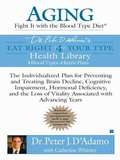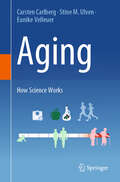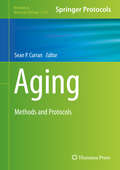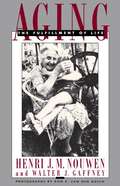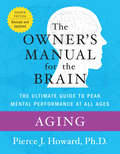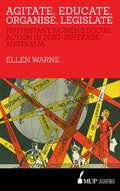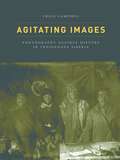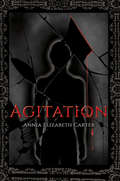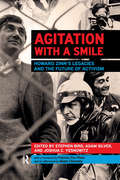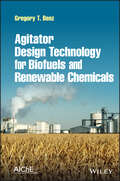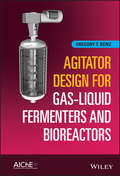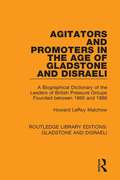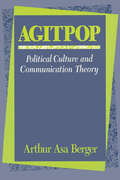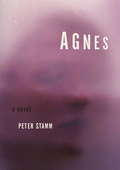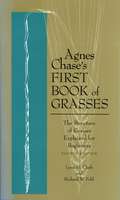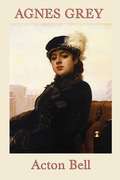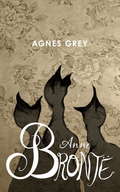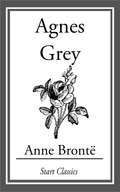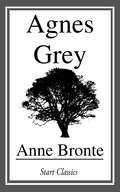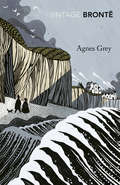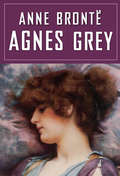- Table View
- List View
Aging: Exploring a Complex Phenomenon
by Shamim I. AhmadThis book is a detailed and comprehensive synthesis of the scientific study of aging. Dozens of contributions from leading scholars review various theories of aging, and molecular, cellular, biochemical and microbial aspects of aging, among just a few of the topics included. Authoritative, wide ranging and thorough, this book will act as a source for experimental design, a comprehensive description of age related diseases, and provide information of the latest molecular theories underlying their causes. Additionally, it will target industries involved in developing anti-aging drugs, post-graduate medical students, and university libraries.
Aging: Fight it with the Blood Type Diet
by Catherine Whitney Peter J. D'AdamoWith specific tools unavailable anywhere else, here is an all-new individualized blood-type-specific plan to gain control over the signs and symptoms of aging. Includes ways to fight brain decline, cognitive impairment, hormonal deficiency, and loss of vitality.
Aging: How Science Works
by Carsten Carlberg Eunike Velleuer Stine M. UlvenAging is a topic that concerns all of us, since none of us can escape it. The molecular and cellular process is built in every of the billions of cells forming our body. Some of these cells, such as immune cells and red blood cells, live only for a few days to weeks and get life-long constantly replaced by cells produced in the bone marrow. In contrast, there are cells, such as neurons and memory lymphocytes, that get as old as we get. The process of aging limits our maximal life span, which is for our humans 120 years. However, only a very few individuals reached this age. How did their life differ from others that died decades earlier? Is it just the absence of life threatening disease paired with a more healthy life style? Or is it build in in our genome or epigenome? In this book we try to give answers to these questions from the perspectives of evolution, our genome, the epigenomes of our different tissues and cell types and the functionality of our cells. We should try to understand ourselves in detail as well as in a global setting. Basic biology explains cellular mechanisms, such as growth, differentiation, and cell death, which make life as a whole possible. Every (human) organism represents a complex interplay between hundreds of different cell types forming distinctive tissues and organs with specialized tasks. These processes need to be highly orchestrated especially during development, maintenance and aging. Studying the cellular and molecular basis of aging is one of the most fascinating areas but also a great challenge. Nevertheless, research made the biggest steps in elucidating biological processes via studying malfunctions of normal mechanisms leading to different diseases, such as progeroid syndrome and cancer. We will start this book with the understanding of the human genome in relation to principles of evolution. Then we will explain the basics of gene regulation and epigenetics, i.e., the interplay of transcription factors and chromatin. Next, we will shift to cellular mechanisms of aging and discuss then the impact of nutrition and immunity on the aging process. In the following the relation of aging to so-called aging-related common diseases, such as type 2 diabetes, atherosclerosis, cancer and Alzheimer. Do we get these diseases because we are aging or are we aging because we get one of these diseases? The book will end how we can slow down the aging process so that we can age healthy. In short, healthy aging is not an option but is a must. An ancient poem says “Teach us to number our days, that we may get a heart of wisdom.” It is up to each one of us and a daily decision to live a healthy lifestyle and to be aware of the unique gift of live we all have.
Aging: Methods and Protocols (Methods in Molecular Biology #2144)
by Sean P. CurranThis volume details the impact of aging on biological system and to understand the basis of this diversity with the goal of elucidating mechanisms to optimize health. Chapters guide readers through different animal models and methodologies to examine aging at the organism, tissue, cellular, and molecular levels across the lifespan. Written in the highly successful Methods in Molecular Biology series format, chapters include introductions to their respective topics, lists of the necessary materials and reagents, step-by-step, readily reproducible laboratory protocols, and tips on troubleshooting and avoiding known pitfalls. Authoritative and cutting-edge, Aging: Methods and Protocols aims to ensure successful results in the further study of this vital field.
Aging: The Fulfillment of Life
by Henri J. M. Nouwen Walter J. GaffneyThe authors share some moving and inspirational thoughts on what aging means (and can mean) to all of us, whether we're in our youth, middle age, or later years. Enhanced by some eighty-five photographs depicting various scenes from life and nature, this book shows how to make the later years a source of hope rather than a time of loneliness -- a way out of darkness into the light. The book shows us all how to start fulfilling our lives by giving to others, "so that when we leave this world, we can be what we have given." It is a warm, beautiful, and caring book: a simple reaffirmation of the promise of Him, who by His aging and death brought new life to this world.
Aging: The Owner's Manual
by Pierce HowardCutting-edge, user-friendly, and comprehensive: the revolutionary guide to the brain, now fully revised and updatedAt birth each of us is given the most powerful and complex tool of all time: the human brain. And yet, as we well know, it doesn't come with an owner's manual--until now. In this unsurpassed resource, Dr. Pierce J. Howard and his team distill the very latest research and clearly explain the practical, real-world applications to our daily lives. Drawing from the frontiers of psychology, neurobiology, and cognitive science, yet organized and written for maximum usability, The Owner's Manual for the Brain, Fourth Edition, is your comprehensive guide to optimum mental performance and well-being. It should be on every thinking person's bookshelf. What are the ingredients of happiness? Which are the best remedies for headaches and migraines? How can we master creativity, focus, decision making, and willpower? What are the best brain foods? How is it possible to boost memory and intelligence? What is the secret to getting a good night's sleep? How can you positively manage depression, anxiety, addiction, and other disorders? What is the impact of nutrition, stress, and exercise on the brain? Is personality hard-wired or fluid? What are the best strategies when recovering from trauma and loss? How do moods and emotions interact? What is the ideal learning environment for children? How do love, humor, music, friendship, and nature contribute to well-being? Are there ways of reducing negative traits such as aggression, short-temperedness, or irritability? What is the recommended treatment for concussions? Can you delay or prevent Alzheimer's and dementia? What are the most important ingredients to a successful marriage and family? What do the world's most effective managers know about leadership, motivation, and persuasion? Plus 1,000s more topics!
Agitate, Educate, Organise, Legislate: Protestant Women's Social Action in Post-Suffrage Australia
by Ellen WarneAfter successfully agitating for the vote for women from the 1890s, Protestant women's organisations in Australia began to educate women at a grassroots level on effective ways of applying political pressure on a wide range of topics and social concerns. Positioning their organisations as non-party-political and separate from more overtly feminist groups, the Woman's Christian Temperance Union (WCTU); the Young Women's Christian Association (YWCA) and the Mothers' Union attracted women who were keen to work for change, and who were seeking to 'save' the individual as well as the greater society. These three organisations sought to agitate on a wide range of issues related to girls and women, connecting with public anxieties and highlighting particular vulnerabilities of girls and young women who lived alone in the city and had the potential to be exploited in the workforce. By the 1920s and 1930s these women's groups noted with concern the easier access to divorce and birth control in the Soviet Union and the growing influence of both Communism and 'Hitlerism' in galvanising young people. Agitate, Educate, Organise, Legislate explores the colourful debates and anxieties that were prevalent from the 1890s to the 1930s and the responses of the key women's organisations whose leadership and campaigns acknowledged that—outside of parliament and party politics—women's connection to political matters could be both innovative and socially influential.
Agitating Images: Photography against History in Indigenous Siberia (First Peoples: New Directions in Indigenous Studies)
by Craig CampbellFollowing the socialist revolution, a colossal shift in everyday realities began in the 1920s and &’30s in the former Russian empire. Faced with the Siberian North, a vast territory considered culturally and technologically backward by the revolutionary government, the Soviets confidently undertook the project of reshaping the ordinary lives of the indigenous peoples in order to fold them into the Soviet state. In Agitating Images, Craig Campbell draws a rich and unsettling cultural portrait of the encounter between indigenous Siberians and Russian communists and reveals how photographs from this period complicate our understanding of this history. Agitating Images provides a glimpse into the first moments of cultural engineering in remote areas of Soviet Siberia. The territories were perceived by outsiders to be on the margins of civilization, replete with shamanic rituals and inhabited by exiles, criminals, and &“primitive&” indigenous peoples. The Soviets hoped to permanently transform the mythologized landscape by establishing socialist utopian developments designed to incorporate minority cultures into the communist state. This book delves deep into photographic archives from these Soviet programs, but rather than using the photographs to complement an official history, Campbell presents them as anti-illustrations, or intrusions, that confound simple narratives of Soviet bureaucracy and power. Meant to agitate, these images offer critiques that cannot be explained in text alone and, in turn, put into question the nature of photographs as historical artifacts. An innovative approach to challenging historical interpretation, Agitating Images demonstrates how photographs go against accepted premises of Soviet Siberia. All photographs, Campbell argues, communicate in unique ways that present new and even contrary possibilities to the text they illustrate. Ultimately, Agitating Images dissects our very understanding of the production of historical knowledge.
Agitation
by Annia CarterSometimes we judge a book by its cover. Sometimes we come to regret that decision. First impressions are all-important, aren't they? But are they always right? Davy can look frightening. He has rages he can't control and a deep-seated frustration at the restrictions placed upon him. Silently resentful, he vows to one day show the world exactly what he is capable of. William is the most charming of men. Successful, good-looking and articulate, he draws others towards him like a magnet. People remember him for all the right reasons. Witty and generous, he certainly seems to be one of life's good guys. On the face of it, two very different men, each hoping his 40th birthday will herald the change that will transform his future, but maybe they have more in common than it first appears. Whilst Davy's aspirations are simple ones, William's are less easy to achieve. As agitation escalates, events take an unhealthy turn and only one man will come to realise that life really does begin at 40.
Agitation with a Smile: Howard Zinn's Legacies and the Future of Activism
by Joshua Yesnowitz Stephen Bird Adam SilverAgitation with a Smile offers a reappraisal of Howard Zinn's political thought and situates his efforts in a contemporary context, looking toward the nature of activism and dissent in the future. This is the first book to provide a substantive account and assessment of Zinn's philosophy and approach to collective action and, to a larger extent, democracy. The contributors to this book explore the most effective mechanisms by which to arouse public support for seemingly radical positions and how current technological advancements may alter our perception of Zinn's activism. The book is a valuable guide to a new generation of activists and scholars of politics in gauging the lasting relevance and legacy of Zinn's ideals, concepts, and methodology. The text is neither fawning nor unduly critical, unlike many discussions of Zinn in popular culture. Rather, the contributors engage the various complexities and tensions present throughout Zinn's work and subject them to contemporary assessment. This is a multidisciplinary and international approach to Howard Zinn's intellectual and activist canon.
Agitator Design Technology for Biofuels and Renewable Chemicals
by Gregory T. BenzAgitator Design Technology for Biofuels and Renewable Chemicals Comprehensive guide to the design, installation, selection, and maintenance of agitators in the biofuels and renewable chemicals industries Agitator Design Technology for Biofuels and Renewable Chemicals is a single-source reference on all the major issues related to agitator design for biofuel, written with the intention of saving the reader time by avoiding the need to consult multiple references or sift through many pages of text to find what is needed for agitator design in specific industries. The work presents a brief introduction of basic principles and relevant theory, then goes on to cover the real-world applications of these principles, including economic evaluations of alternatives as well as supplier evaluation principles. To aid in quick and seamless reader comprehension, each chapter has the symbols used in that chapter listed and defined at the end. Overall, the work is written more as a how-to book than an academic treatise. The highly qualified author has included plenty of brevity throughout the pages with the hopes that readers go through the entire book as a single unit, rather than just skimming an occasional page or chapter as is common with other resources in similar fields. Sample topics covered in the work include: Avoiding common problems, such as using impeller diameters and speeds that would not result in even minimal solids suspension or liquid motion Choosing the right impellers for the job, understanding how power draw and pumping are calculated, and becoming familiar with biofuel/biomass agitator sizing guidelines The principles and limitations of scale-up and the most common non-Newtonian rheology applicable to biofuel applications Designing lab tests and scale-up cellulosic hydrolysis agitation, plus the uses and limitations of Computational Fluid Dynamics (CFD) As an easy-to-read and completely comprehensive resource to the subject, Agitator Design Technology for Biofuels and Renewable Chemicals is immensely valuable for professionals tasked with selecting agitation equipment or troubleshooting existing equipment, as well as those involved in planning activities and allocating resources related to project management.
Agitator Design for Gas-Liquid Fermenters and Bioreactors
by Gregory T. BenzThis book is concise reference to designing mechanically sound agitation systems that will perform the process function efficiently and economically. Currently, all the books on bioreactor and fermenter design do not focus specifically on agitation. Sections cover agitator fundamentals, impeller systems, optimum power and air flow at peak mass transfer calculations, optimizing operation for minimum energy per batch, heat transfer surfaces and calculations, shaft seal considerations, mounting method, mechanical design, and vendor evaluation.
Agitators and Promoters in the Age of Gladstone and Disraeli: A Biographical Dictionary of the Leaders of British Pressure Groups Founded Between 1865 and 1886 (Routledge Library Editions: Gladstone and Disraeli #2)
by Howard LeRoy MalchowOriginally published in 1983, Agitators and Promoters in the Age of Gladstone and Disraeli brings together the lives of thousands of persons, some famous, most modest and obscure, who were joined a century ago in pursuit of causes promising, a more just world which embodied much of the life and substance of the politics of during this time of transition. The book focuses on not simply the political Establishment but the members of government and legislature with their paid functionaries and party hacks, and much of the politicised sub-elite of a generation, including some three thousand persons from many layers of Victorian life. These are the organisers and leaders, the agitators and promoters of a host of causes.
Agitpop: Political Culture and Communication Theory
by Arthur Asa BergerIn this entirely sophisticated and scholarly account of political culture, Arthur Asa Berger shows how the variety of cultural preferences creates the foundations of communication theory. Using the work of Aaron Wildavsky, the author shows how individualism, egalitarianism, collectivism, and fatalism form the basis of culture in complex societies. But more importantly, Berger breaks down the mechanical distinction between mass culture and elite culture, showing how they interpenetrate and crossover at the level of competitive and hierarchical frames. Agitpop, now in paperback, suggests that there is an ideological content to our popular culture, even though the creators no less than the consumers of that culture are either unaware or dimly aware that they are creating works with an ideological bent. The work takes up in quick order two examples from different areas of the hierarchical, individualist, egalitarian, and fatalist cultures. From football games to the Iran-Contra Hearings, from MTV to the Human Potential Movement, from Max Headroom to humor on the Jews, and from wrestling to The Terminator, Berger takes up his master themes with a deft touch of his own. Weaving in the work of scholars from Emile Durkheim to Aaron Wildavsky he manages to make each of the chapters very much his own. For those who know the earlier work of this author, the reader will be very much at home; for those new to Berger, the volume will be a joyous revelation. The final three chapters reveal a deeper aspect of Berger's work. His interpretation of the earlier materials in terms of the semiotics of power, of textual analysis, or deconstruction of the media, and finally, an analysis and self-analysis of the larger research agenda of which this work is pivotal, should make this book central to the theoretical construction of popular and political culture. For people working in communications theory, political culture, and the sociology of knowledge, this book is a must; for everyone els
Agnes
by Peter Stamm John CullenPeter Stamm's best-selling debut novel, Agnes, now available for the first time in the United States. "Write a story about me," Agnes said to her lover, "so I know what you think of me." So he started to write the story of everything that had happened to them from the moment they met. At first, he works with Agnes to create a narrative that is most true to life, but as time passes and he grows more enamored with the narrative he has begun, he continues writing on his own, imagining a future for them after he reaches the present. Happy couples do not necessarily make for compelling reading, and as Agnes sees the unexpected plot he has planned for her, the line between fiction and reality begins to blur. In this unforgettable and haunting novel Stamm incisively examines the power of storytelling to influence thought and behavior, reaching a chilling conclusion.
Agnes Chase#s First Book of Grasses: The Structure of Grasses Explained for Beginners, Fourth Edition
by Lynn G. Clark Richard W. PohlFor almost seventy-five years, Agnes Chase's First Book of Grasses has been the classic guide to the structure of this complex group of plants. Clearly written and copiously illustrated with line drawings, the book is accessible to those with little or no botanical training, yet it also is respected by botanists as an authoritative introduction to agrostology.Last updated in 1959, the book now has been thoroughly revised to reflect current scientific knowledge, nomenclature, and classification. Divided into twelve lessons, the guide first surveys the basic vegetative and reproductive parts of a grass plant, then in succeeding lessons takes up increasingly more complex modifications. Formally recognized groups of grasses are discussed in a taxonomic context, with the principal focus on grass structures, particularly those of inflorescences and spikelets. Virtually all of the species discussed are illustrated with detailed line drawings. With the addition in this edition of a lesson on bamboos, coverage now extends to tropical regions and encompasses all major groups of grasses. The book also includes a short biography of Agnes Chase in the foreword and, for the first time in this edition, a glossary accompanies the appendices on grass classification.
Agnes Grey
by Acton BellThe novel follows Agnes Grey, a governess, as she works in several bourgeois families. The choice of central character allows Anne to deal with issues of oppression and abuse of women and governesses, isolation and ideas of empathy. An additional theme is the fair treatment of animals. Agnes Grey also mimics some of the stylistic approaches of bildungsromans, employing ideas of personal growth and coming to age, but representing a character who in fact does not gain in virtue.
Agnes Grey
by Anne BronteThe unsung jewel of the Brontë sisters' works. Agnes Grey, the daughter of a minister, finds work as a governess to help with her family's precarious finances. As she moves from family to family she is exposed to the darker side of the British aristocracy, and must figure out for herself how to find happiness. Penguin Random House Canada is proud to bring you classic works of literature in e-book form, with the highest quality production values. Find more today and rediscover books you never knew you loved.
Agnes Grey
by Anne BronteA novel that addresses the precarious position of a governess, and how it affected a young woman in that position: some critics, in fact, feel that Agnes Grey deserves the reputation of a 'governess novel' far more than Jane Eyre, as it is decidedly more realistic and down-to-earth in its depiction of the life of a governess.
Agnes Grey
by Anne BronteA novel that addresses the precarious position of a governess, and how it affected a young woman in that position: some critics, in fact, feel that Agnes Grey deserves the reputation of a 'governess novel' far more than Jane Eyre, as it is decidedly more realistic and down-to-earth in its depiction of the life of a governess.
Agnes Grey
by Anne BronteIn her daring first novel, the youngest Brontë sister drew upon her own experiences to tell the unvarnished truth about life as a governess. Like Agnes Grey, Anne Brontë was a young middle-class Victorian lady whose family fortunes had faltered. Like so many other unmarried women of the nineteenth century, Brontë accepted the only "respectable" employment available — and entered a world of hardship, humiliation, and loneliness.Written with a realism that shocked critics, this biting social commentary offers a sympathetic portrait of Agnes and a moving indictment of her brutish and haughty employers. Separated from her family and friends by many miles, paid little more than subsistence wages, Agnes stands alone — both in society at large and in a household where she is neither family member nor servant. Agnes Grey remains a landmark in the literature of social history. In addition to its challenge to the era's chauvinism and materialism, it features a first-person narrative that offers a rare opportunity to hear the voice of a Victorian working woman.
Agnes Grey
by Anne BronteDiscover the lesser-known but brilliant novel by the hugely under-appreciated Anne Brontë.When Agnes’s father loses the family savings, young Agnes determines to make her own living – as a governess. Working for the Bloomfields, her enthusiasm is soon dampened by isolation and the cruelty of the children in her charge. Agnes hopes for better in her second job, but when the scheming elder daughter Rosalie makes designs on Agnes’s new friend, the kind curate Mr Weston, she feels herself silenced and sidelined. Becoming a governess is one thing, becoming invisible is quite another. WITH AN INTRODUCTION BY SAMANTHA ELLIS
Agnes Grey
by Anne BrontëAt age 19 Anne Brontë left home and worked as a governess for a few years before becoming a writer. Agnes Grey was an 1847 novel based on her experience as a governess. <P> <P> Bronte depicts the precarious position of a governess and how that can affect a young woman. Agnes was the daughter of a minister whose family was in financial difficulty. She has only a few choices for employment. Agnes experiences the difficulty of reining in spoiled children and how wealth can corrupt morals.
Agnes Grey
by Anne BrontëA largely autobiographical work, Agnes Grey is the tale of a lowly governess in the employ of the English gentry. The novel examines the contempt and inhumanity shown towards the poor though educated women of the Victorian Age, whose only resource was to become a governess.

